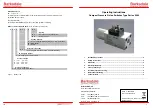
Management Commands
670
ProSafe Managed Switch
The SNMP agent of the switch complies with SNMP Versions 1, 2 or 3. For more information
about the SNMP specification, see the SNMP RFCs. The SNMP agent sends traps through
TCP/IP to an external SNMP manager based on the SNMP configuration (the trap receiver
and other SNMP community parameters).
Format
show snmpcommunity
Mode
SNMP
Community
Name
Client IP
Address
Client IP Mask
Access Mode
Status
show snmptrap
Use this command to display SNMP trap receivers. Trap messages are sent across a
network to an SNMP Network Manager. These messages alert the manager to events
occurring within the switch or on the network. Six trap receivers are simultaneously
supported.
Format
show snmptrap
Mode
SNMP Trap
Name
IP Address
IPv6 Address
SNMP Version
Status
The following shows an example of the CLI command.
Privileged EXEC
Term
Definition
The community string to which this entry grants access. A valid entry is a case-sensitive
alphanumeric string of up to 16 characters. Each row of this table must contain a unique
community name.
An IP address (or portion thereof) from which this device will accept SNMP packets with
the associated community. The requesting entity's IP address is ANDed with the Subnet
Mask before being compared to the IP address. Note: If the Subnet Mask is set to
0.0.0.0, an IP address of 0.0.0.0 matches all IP addresses. The default value is 0.0.0.0.
A mask to be ANDed with the requesting entity's IP address before comparison with IP
address. If the result matches with IP address then the address is an authenticated IP
address. For example, if the IP address = 9.47.128.0 and the corresponding Subnet
Mask = 255.255.255.0 a range of incoming IP addresses would match, i.e. the incoming
IP address could equal 9.47.128.0 - 9.47.128.255. The default value is 0.0.0.0.
The access level for this community string.
The status of this community access entry.
Privileged EXEC
Term
Definition
The community string of the SNMP trap packet sent to the trap manager. The string is
case sensitive and can be up to 16 alphanumeric characters.
The IPv4 address to receive SNMP traps from this device.
The IPv6 address to receive SNMP traps from this device.
SNMPv2
The receiver's status (enabled or disabled).
















































